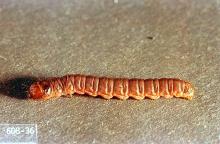Dioryctria spp.
Pest description and damage Adult coneworms are mottled gray or brown snout moths banded with subtle waves of color and about 0.6 to 0.7 inch in length. The coneworm larvae are small and cream-colored or light brown with a darker head. Coneworms attack true firs by boring into shoot tips or stems, especially around wounds, and feeding on the soft bark tissues. The portion of the branch beyond the injured point may die back. Coneworms also may bore into green cones, feed on the soft bark of young growth, or feed inside the bark on the trunk cambium. There are many species of Dioryctria that feed on different parts of small plants, trunk and shoots as well as cones. Confounding the issue are insects of other orders that attack cones and several other small moths that bore into shoots.
For biology, life history, monitoring and management
See:
Douglas-fir (Pseudotsuga)-Coneworm
Management-chemical control
See Table 4 in:




